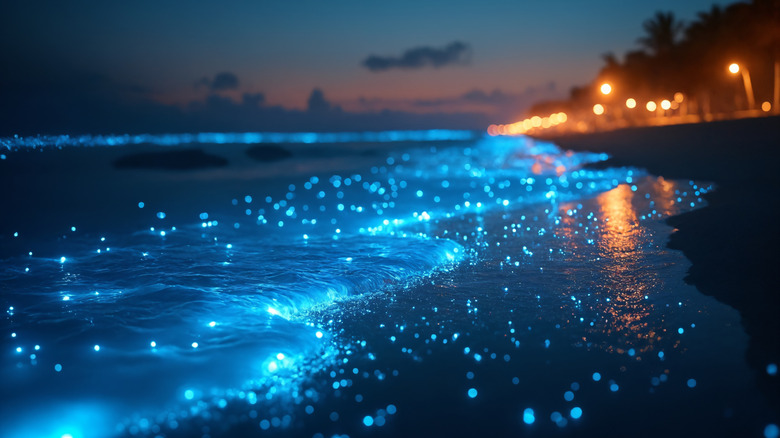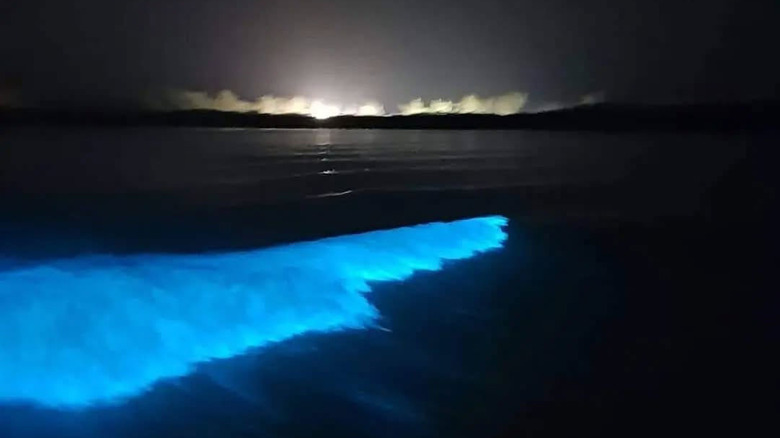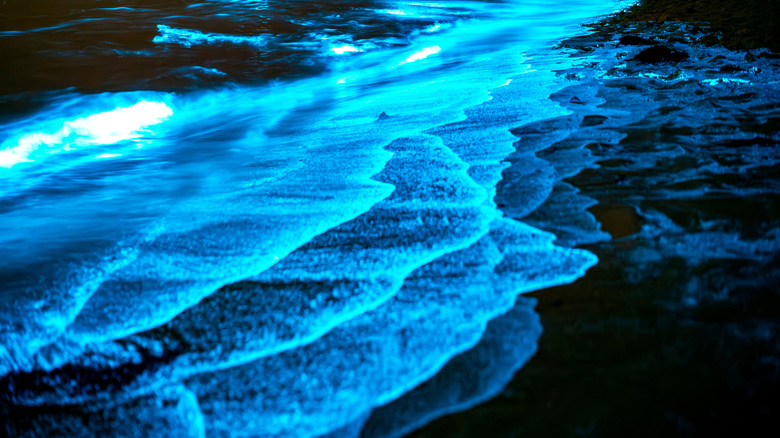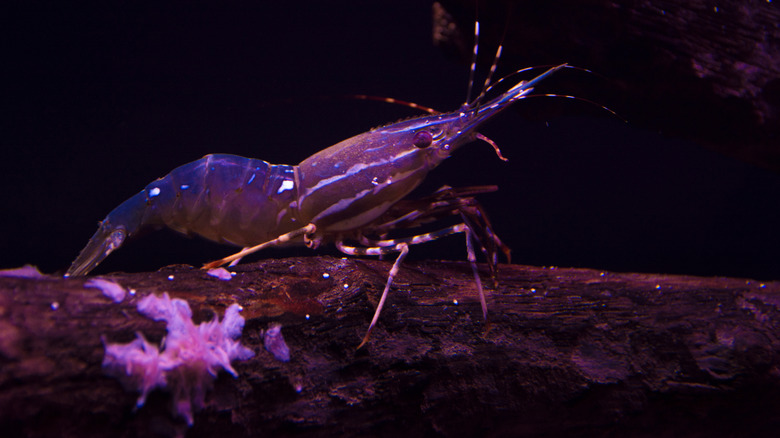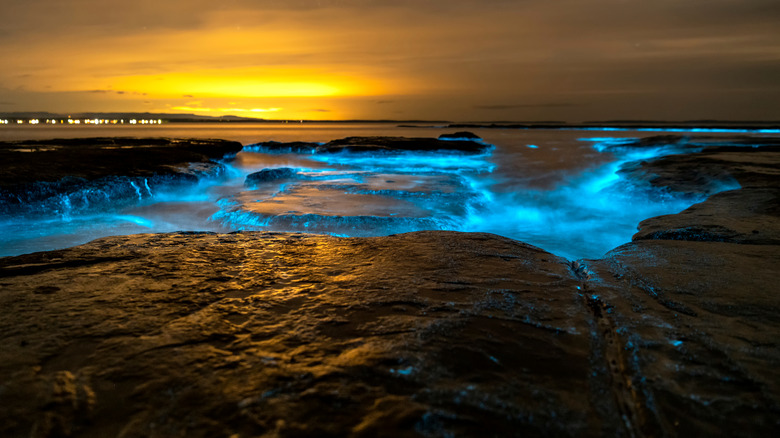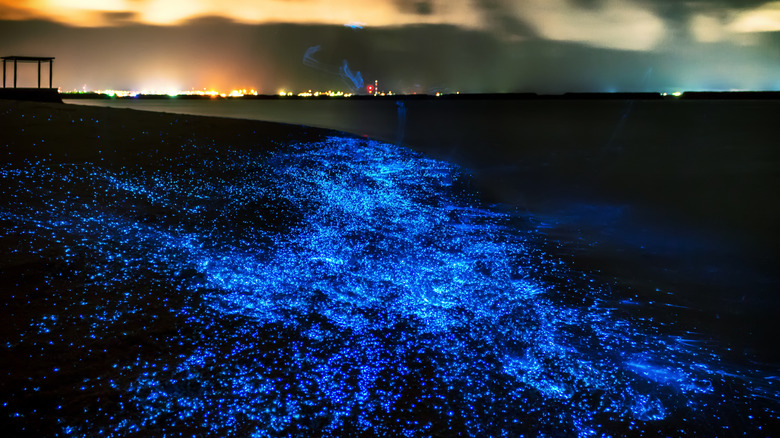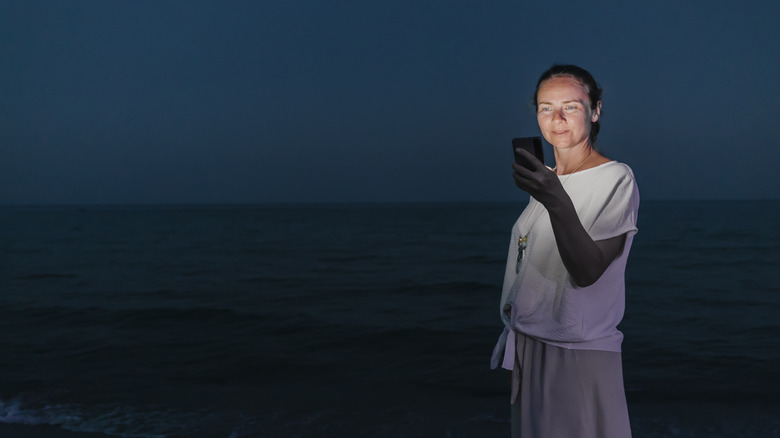The Best Beaches To Watch Bioluminescent Waves (Other Than Florida), According To Research
If you've ever encountered a deserted beach all to yourself at nighttime, you're probably familiar with the overwhelming sense of peace and solitude it can bring. But arrive at the right location under the right conditions, and you might get to encounter bioluminescence, a phenomenon where sea water glows electric blue with every wave. This natural occurrence is science at its finest, where living organisms in the sea emit bioluminescence as a means of communicating, attracting a mate, or deterring predators. In fact, a 2017 article in Scientific Reports studying marine organisms at various ocean depths showed that around 76% of the observed organisms possessed bioluminescent capabilities.
Small deep-sea creatures such as fish, jellyfish, worms, and crustaceans produce bioluminescence, but ocean depth isn't necessarily a condition for bioluminescence to glow. The glittering bioluminescent displays on the ocean's surface are caused by dinoflagellates — single-celled phytoplanktons that glow when agitated by waves, swimmers, or passing sea creatures. Though impossible to predict the occurrence, the right conditions, such as warm, windless waters on moonless nights, can increase your chances of seeing this phenomenal light show. And while Florida is one of the best destinations to see mesmerizing bioluminescent waves, there are other destinations where bioluminescence occurs. From the beaches of Puerto Rico all the way to Japan, we rounded up the best bioluminescent shores around the world by researching other "best of" lists and travel guides from trusted sources. (Find more information on our methodology at the end of this article.)
Luminous Lagoon in Falmouth, Jamaica
Located in Falmouth, Jamaica, the Luminous Lagoon formerly welcomed the passage of rum and sugar ships in the 18th century, but today the boats that chug along its surface are filled with tourists eager to experience one of the most vibrant bioluminescent destinations in the Caribbean. The lagoon's water — formed by the the Martha Brae River and the Caribbean Sea — is quite shallow and warm, perfect conditions for bioluminescence to occur, as well as for visitors to swim in its waters and literally bask in its glow.
Favorable weather conditions in the area allow tours to run throughout the year, but anytime between December and April gives you more chances to catch the lagoon's light show, when the skies are clearer. Save for storms and heavy rains that fall during May through November (Jamaica's rainy season), you're likely to still see bioluminescence, albeit not as brightly as on a clear, calm night.
The Luminous Lagoon can be visited via organized group or private boat tours; hotels can usually book one for you with transportation to and from the lagoon. Take some bug spray to combat mosquitos, and wear water shoes if you're queasy about being barefoot on the murky lagoon floor. You don't have to jump into the water, but you'd be missing out on a magical experience if you don't. And while selfies are the norm in such cases, a phone camera won't be able to handle the low-light atmosphere. Don't despair — your tour boat will most likely have a professional photographer on board, so bring along some cash for a photo op, and for tipping your tour guide as well.
Mosquito Bay in Vieques, Puerto Rico
Due to its narrow, S-shaped opening from bay to ocean, the dinoflagellates that light up the waters of Mosquito Bay give off one of the strongest and most impressive displays of their kind — so much so that the location won the 2006 Guinness World Records distinction as the brightest bioluminescent bay in the world. Located on the island of Vieques, nestled in a protected reserve bordered by mangroves, Mosquito Bay promises a rewarding, once-in-a-lifetime experience — if you're ready to put in some effort to get there. The island can be reached from San Juan via a 30-minute flight, or from Ceiba via a one-hour ferry.
Named not because of mosquitos but after the Puerto Rican pirate ship El Mosquito, the bay's luminescence was considered black magic, prompting people to leave the pirate ship crew alone. Today, pirate ships have been swapped for kayaks, rowed by curious tourists chasing after the exhilarating bioluminescent experience. Solo adventure travelers can't go off-book, though, as visitors are required to book tours with licensed operators only, a protective measure by the country's Department of Natural Resources. (Tours can be organized by hotels or tour companies in the town center, Esperanza.) No swimming is allowed in the bay to protect the organism population. Sit out a trip during full moon, and always double-check the weather with your tour operator before heading out. Try targeting December to February to avoid rainy season as well as the throngs of March spring break vacationers.
Toyama Bay in Toyama Prefecture, Japan
While the months of March to May are the absolute best time of the year to visit Japan to see its cherry blossoms, a vastly different spectacle takes place in Toyama Bay, located on Japan's west coast: the blue bioluminescence of firefly squid. Measuring about 3 inches, these cephalopods surface from the depths of the bay for mating season, tentacle tips alight. Being a delicacy, fisherman round up the squid in fixed nets, creating glittering wells of blue light in the inky black water. It is the early-morning hauling of glowing squid that makes it such a unique and ephemeral attraction.
Since there's a narrow window to marvel at this extraordinary event, proper planning is required. Be prepared for a 3 a.m. departure on a tour boat from the fishing port of Namerikawa — needless to say, reservations must be made ahead of time. Tours can last about two hours; after the bioluminescent show, you're perfectly positioned on the water to enjoy a sunrise over the Tateyama Mountains on the horizon.
However, book a tour with a grain of salt, as weather conditions can cause last-minute cancellations — not very practical, yet not unheard of, with the event being at the mercy of the weather gods. Redditor u/zeecatman had a booked tour push through despite the wind, resulting in a squid no-show and "a complete failure and a huge waste of the early hours of my day."
Jervis Bay in New South Wales, Australia
Australia spoils visitors with a choice of top islands and coastal getaways — so much so that it's pretty hard to pin one down for a trip. But if you're looking for something out of this world, a three-hour trip south of Sydney to Jervis Bay can grant you that wish in the form of waters that shimmer with glowing plankton lapping up to the bay's shores.
It's almost impossible to predict when the Noctiluca scintillans, or "Sea Sparkles," a dinoflagellate typically populating the southern Australia coast, will show up, but there are more chances than not that they will appear as the warm weather creeps in. The lack of artificial light, calm waters, and a clear, moonless sky anywhere between November and April are favorable indicators of Sea Sparkles lighting up the water — and so is the presence of red algae during the daytime. Your best location bet for encountering bioluminescence? Spots like Callala Bay, Hyams Beach, Scottish Rocks Beach, or Barfleur Beach, where a concentration of plankton is sheltered and kept away from strong currents.
Anywhere in the Maldives, really
As if the Maldives' gorgeous white-sand beaches, picturesque atolls, and crystal-clear waters weren't enough to live up to its paradisiacal reputation, the islands pull out another showstopper worthy of a bucket-list spot: an intense bioluminescent display that commonly occurs across the island's warm waters. And while a Google search for bioluminescence in the Maldives will normally bring up Vaadhoo Island, bioluminescence caused by a concentration of plankton can actually grace any of the beaches across the scattered isles, especially those with minimal artificial light and development. Good spots include Fulidhoo in Vaavu Atoll, or the islands of Dhangethi and Dhigurah (the latter of which has a 2-mile undeveloped shoreline) in South Ari Atoll.
So now that we know where a possible bioluminescence sighting can take place, when is the best time frame to catch it? Having worked in the Maldives for eight years, marine biologist Lauren Arthur told the BBC that April through October — Southwest Monsoon season — will most likely wash wave after wave of glittering plankton up to the shores. And because the beaches are fair game, meaning without any restrictions unlike protected bioluminescence areas, visitors can literally float in a swirling sea of plankton by taking a night snorkel or dive, turning off all light sources, and thrashing about in the water to disturb the plankton. The new moon phase also increases your plankton-sighting chances.
Our methodology
Our bioluminescent beach picks were whittled down from "best of" lists we found through internet research, including coastal travel platform Beach.com, travel site TripSavvy, and Lonely Planet, among others. We brushed up on the science behind bioluminescence through informative articles from National Geographic, ScienceDaily, and Scientific Reports. After prioritizing accessible, familiar, and well-known travel destinations, we delved into the specifics through informational sites such as official tourism websites, bioluminescence tour guide companies, and various travel websites.
And since bioluminescence is such a fascinating yet elusive occurrence, we sought out valuable, first-hand accounts and advice from Reddit forums, Tripadvisor reviews, and travel bloggers on timing, personal anecdotes, and bio bay tour information concerning bioluminescent beaches.
